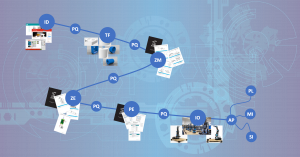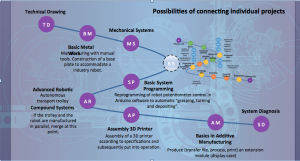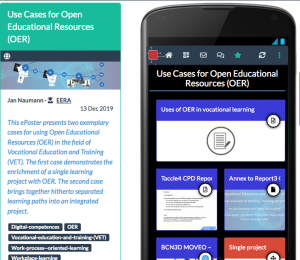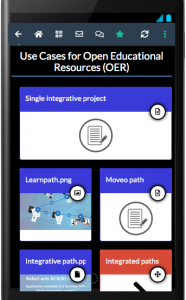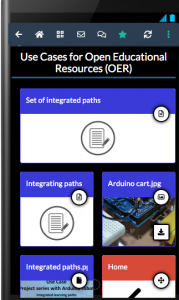Some time ago I had a chat with my colleague Gilbert Peffer on the recent progress with the Learning Toolbox (LTB) that was developed in our common project. I was so impressed that I wrote a blog post on our discussion. Moreover, we agreed to continue these discussions and to introduce a new format of communication – Blogchat. This means that we agree on regular online sessions on agreed themes and that I will publish notes on our talks. So, here we go.
ePosters as a major spin-off of the Learning Toolbox (LTB)
Ever since our EU-funded Learning Layers project came to an end in the beginning of the year 2017 I have engaged myself in the follow-up activities with focus on the Learning Toolbox (LTB). In particular I have been interested in the success story of the ePosters (powered by LTB) that have become popular in many conferences. I have been writing blogs on the first pilots in conferences of medical educators and educational technologists. And I was heavily engaged in the pilot that we organised (together with the LTB-developers) at the ECER 2018 in Bolzano/Bozen, Italy. That pilot could not be continued since the organising body – European Educational Research Association (EERA) was at that point tied up with other change agendas. So, afterwards my knowledge on the use of ePosters was rather sporadic. Indeed, I have become aware of many awards that the LTB-developers have received and congratulated them via my blog posts. Yet, I have not got an overview, how strongly our colleagues are making progress. So, it was high time to get a proper update.
Firstly, I was impressed when Gilbert told me about the conferences with which they are working. In the year 2019 the LTB-developers supported fourteen (14) conferences that used ePosters (powered by LTB) in their program. Most of these took place in Europe. For the year 2020 they have already fifteen (15) agreements, half of them taking place in Europe and the rest outside Europe. Moreover, they have agreements with biennial conferences that take place every two years. And, what is most interesting, is the fact that almost all conferences that have piloted with ePosters are now regular users. They have found their ways to integrate the ePosters to their conference cultures.
ePosters are more than mere e-posters
As I have seen it – from afar and from our joint experience – the ePosters made their breakthrough as alternatives to traditional paper posters. For many conferences that had struggled with the space needed for poster sessions and for accommodating the desired number of presentations on a limited number of poster sessions this was a relief. Moreover, some conferences had been frustrated with commercial e-poster software (that didn’t bring much added value). From that perspective the functionality of LTB-powered ePosters was a great step forward:
- All ePosters could be presented as mini-posters on a poster wall or poster cubicle throughout the conference.
- With the help of QR-codes all conference participants could download the ePosters they were interested in and access them whenever they had time.
- It was possible to arrange informal meetings between presenters and participants in the vicinity of the poster walls in a flexible way.
- The presenters didn’t need to use much time in poster discussion sessions – they could be shaped as actively interactive events (such as barcamps or ePoster arenas).
However, this is not the whole story of ePosters as an innovation in conference culture. Some conferences have become concerned about travel expenses, carbon footprints and travelling times due to presence sessions in conferences. In this respect one of the forthcoming conferences is organising a pre-conference week that is based on the availability of ePosters on the web already one week before the presence conference. The organisers invite presenters and online participants to a Zoom meeting on the respective ePosters. Then, the recording of the discussion session will be added to the respective LTB stack. From this perspective the emphasis is gradually shifting from ePosters (to be viewed) to ePresentations (that can be discussed with the help of digital media).
Finally, a major asset with the ePosters is that they provide for conference organisers a domain, on which they can keep the legacy of ePosters in successive conferences. This is already the case with the pioneering conferences of healthcare educators. They can now give access to ePosters of their conferences during the last few years.
